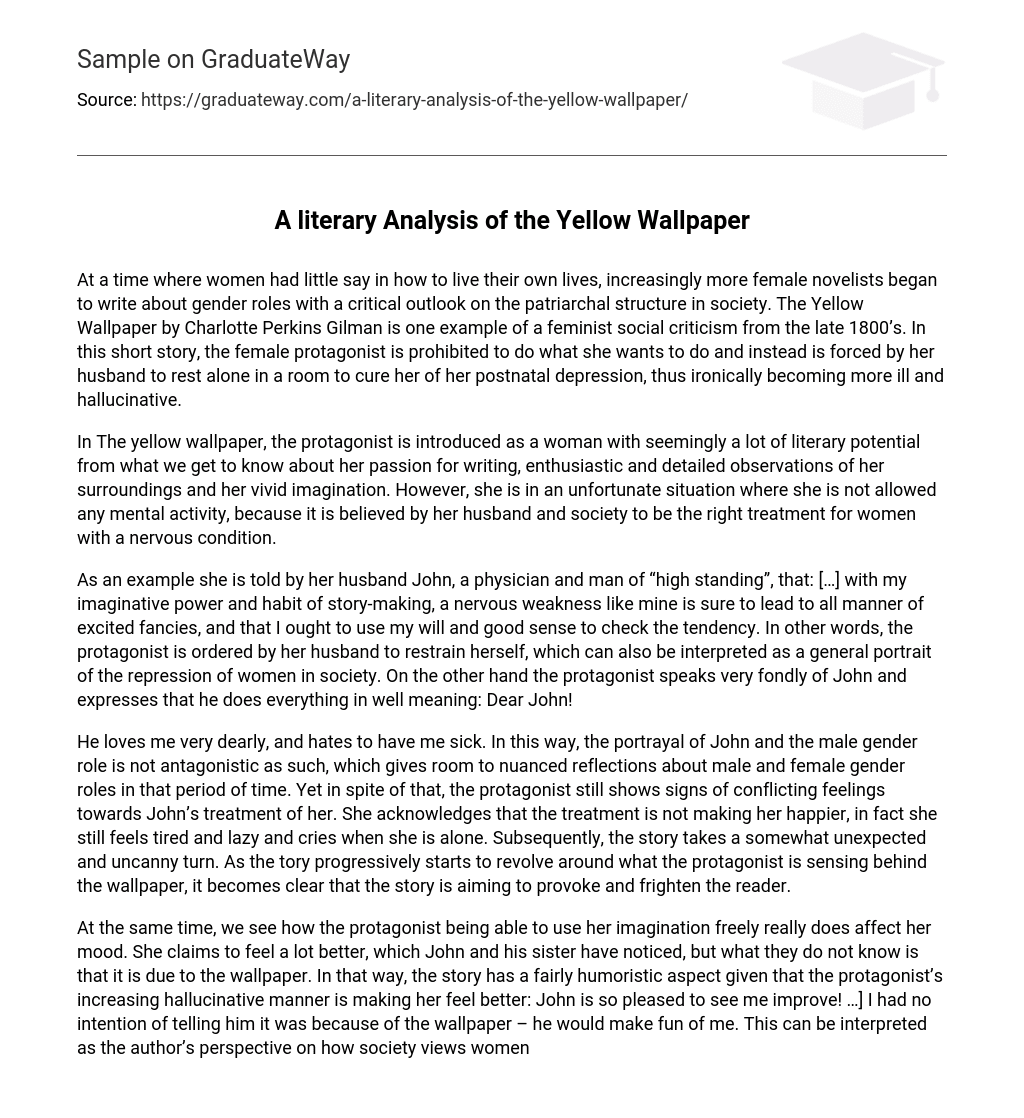During a time when women had limited control over their lives, an increasing number of female writers started to address gender roles with a critical perspective on society’s patriarchal system. Charlotte Perkins Gilman’s The Yellow Wallpaper is a feminist critique from the late 1800s that exemplifies this trend. The story depicts a female protagonist who is denied agency and instead compelled by her husband to seclude herself in a room for the purpose of curing her postnatal depression. Ironically, this isolation only worsens her condition and leads to hallucinations.
The protagonist of The yellow wallpaper is initially presented as a woman with great literary potential, demonstrated through her passion for writing, keen observations, and vibrant imagination. Unfortunately, she finds herself in a distressing predicament where she is forbidden from engaging in any mental activity, as her husband and society view this as the appropriate course of treatment for women suffering from nervous conditions.
The protagonist’s husband, John, who is a physician and highly respected, tells her that due to her vivid imagination and tendency to create stories, her nervous weakness is likely to result in various excessive fantasies, and advises her to use her willpower and common sense to control this inclination. In essence, she is instructed by her husband to suppress herself, which can be seen as a representation of the societal oppression of women. However, the protagonist holds deep affection for John and believes that his intentions are always good. Therefore, she addresses him affectionately as “Dear John!”
John loves me deeply and despises seeing me ill, thus the depiction of John and the male gender role is not necessarily antagonistic, allowing for nuanced contemplation of gender roles during that era. However, the protagonist still demonstrates conflicting emotions towards John’s treatment. She acknowledges that his approach does not bring her happiness; instead, she continues to feel exhausted and unmotivated, shedding tears in solitude. Consequently, the narrative takes an unexpected and eerie turn. As the story progressively revolves around the protagonist’s perceptions behind the wallpaper, it becomes evident that its intention is to unsettle and terrify the reader.
The protagonist’s ability to freely use her imagination significantly impacts her mood, resulting in her feeling much better. John and his sister have noticed this change, but they are unaware that it is caused by the wallpaper. This aspect adds a humorous element to the story, as the protagonist’s increasing hallucinations contribute to her improved state: “John is so pleased to see me improve! …] I had no intention of telling him it was because of the wallpaper – he would make fun of me.” This can be seen as the author’s perspective on how society perceives women who dare to think and behave as they please, without restraint. Additionally, another passage where the author combines horror and humor occurs at the end when the protagonist, having broken free from behind the wallpaper, stealthily moves about the room: “You get the image of an insane woman who is creeping around on her knees and stepping on her fainted husband when she passes by him: Now why should that man [John] have fainted?”
Despite my attempts to avoid him, he lay directly in my path by the wall, forcing me to carefully maneuver around him on each occasion! Undoubtedly, this portrayal was intended to shock readers during that era. Alternately, it can be inferred that the author aimed to illustrate the reversal of roles between the protagonist and John. It serves as a depiction of the woman being dominant while the man remains completely subdued. What adds to the irony is that this image manages to be simultaneously frightening and shocking, potentially highlighting the author’s commentary on societal perspectives regarding women wielding power.
Charlotte Perkins Gilman skillfully employs elements of the horror genre in her work, The Yellow Wallpaper, to critique the societal views of women during the late 1800’s. The story exposes a society that did not perceive women as competent leaders or having authority over men, thus reflecting the feminist social criticism prevalent at that time. Gilman’s writing is influenced by renowned female authors like Jane Austen, who played a vital part in the discourse on gender roles and women’s rights. By incorporating these horror elements into her narrative, Gilman stimulates and enlightens her readers.





